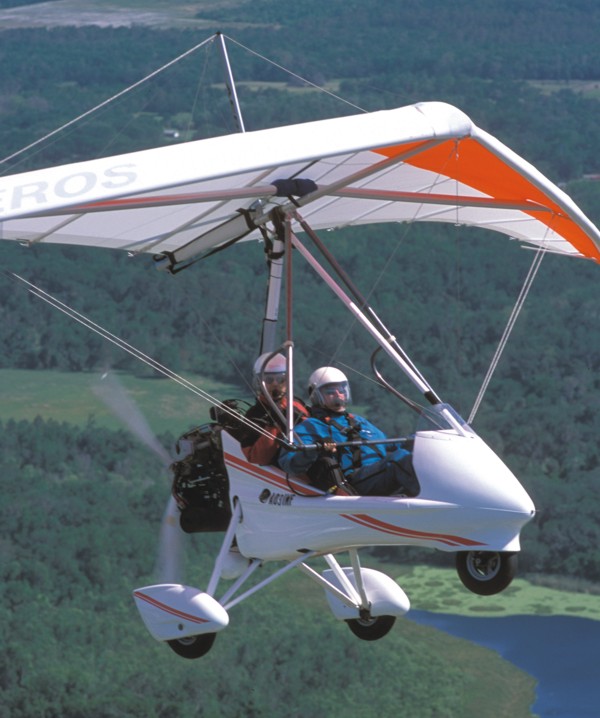
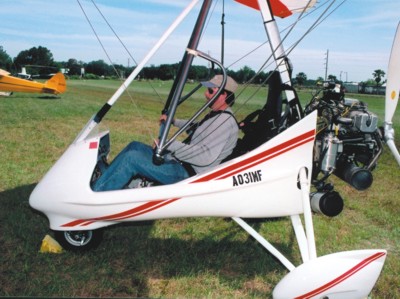
SWEEPING LINES – Joe Lunn, a large fellow who fits the front seat well, models the Velocity from Aeros.
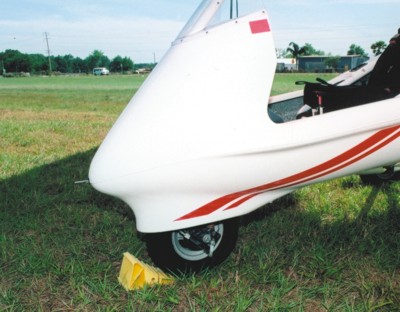
NOSE TREATMENT – Aeros engineers created a pleasing shape that moves air around the nosewheel quite efficiently. The glasswork was excellent.
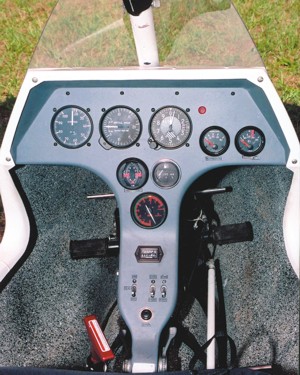
TEE PANEL – The classic T-panel shape works well in the Velocity. Multi instruments with glass screens should also fit well. Note the BRS parachute handle to the lower left; this is a good placement for that handle.

OPTIMAL SHAPE – The hang glider-type wing has evolved a long way in modern trike usage. Wire bracing is still common though hang gliders have gone to internal spars.
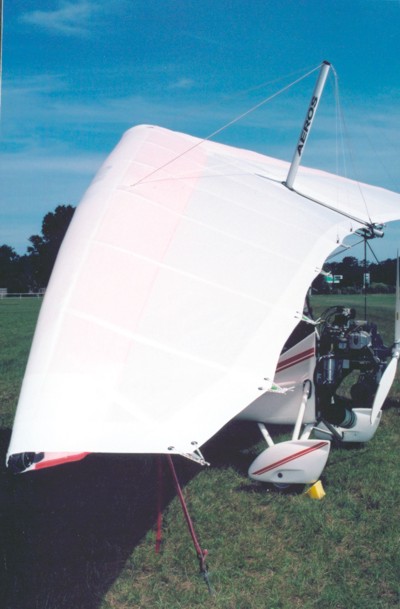
WINGMAKERS ART – Sewing a Dacron sail into a wing with supportive rib structure and internal controls is a partially artistic endeavor. Aeros reveals how good they are with this very clean Still wing.

HKS POWER – The smooth-running 60-hp HKSE engine powers the Velocity with more than adequate power. While a few horses shy of a 65-hp Rotax 582, it sounds better and uses less fuel with a much longer overhaul period.

BIG POWER – Amazingly in a world of Rotax 912s, the Rotax 447 can be viewed as offering power to excess. But on this lightweight SkyCycle trike, you don’t need (and may not want) full power for takeoff.

SIMPLE BASICS – Even while the Super SkyCycle is extraordinarily simple, by design, it has acquired some creature comforts and styling not found on earlier models.

INNER VIEW – A glance inside the wing on the SkyCycle shows a modern hang glider stability system; the tube inserted in the leading edge assures the wingtip stalls last. You can clearly see the twist in the wing.

BASIC GAUGES – With glass cockpits all the rage, here are just the basics to monitor your engine. Flight instruments are often affixed to the wing’s control bar, as that’s where they mount when foot-launching. Most hang glider pilots use small electronic devices focused on soaring and navigation.

STRONG BACK – One central structure point shows where the ballistic parachute is attached. The wing nut shows this is where the mast can fold for wing attachment or transport.
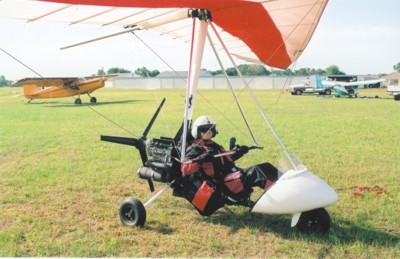
Ultralight Flying! Flight Reporter Dan Johnson models the SkyCycle Super after his evaluation of this very basic trike.
Ukrainian airframe producer Aeros has risen from complete obscurity in the early 1990s (after the Berlin Wall fell) to wide recognition in recreational aviation. Although powered ultralight and light-sport aircraft enthusiasts may not immediately know the brand, hang glider pilots around the world are very aware of the name. The current reigning world champion hang glider pilot is Oleg Bondarchuck, a Ukrainian pilot who works with Aeros.
This young company emerging from the former Soviet mantel also makes an ultralight sailplane plus two powered aircraft. Aeros produces the Sky Ranger 3-axis airplane (under agreement with its French designer), and it has designed and markets its own trike. The company also supplies trike wings for other producers like Antares. By any normal measurements, Aeros is a versatile company.
Many ultralight and LSA pilots probably know the Aeros Velocity trike, and may recall its earlier name, Venture. In those days, it was sold by Sabre Aircraft alongside the trikes that Arizona company made here in America.
Today’s importer, GT Ultralights, renamed the weight-shift aircraft the Velocity. GT Ultralights is an affiliate of Lookout Mountain Flight Park, one of the country’s largest hang gliding schools and flying sites. Both are located in North Georgia not far from where Ultralight Flying! is published. I flew with Joe Lunn earlier this spring.
What’s Our Velocity?
Being a more mature market segment than powered parachutes, suppliers of weight-shift aircraft have narrowed to a few significant companies. Given the exquisitely designed trikes Aeros is up against, why should you select this particular aircraft? This is a common question in light aviation as we enjoy so many choices.
The Velocity matches the leaders of weight-shift aircraft production by designing all parts of the rig themselves. While some American suppliers (North Wing and Concept Aviation, for example) create their own wings, other trike carriage suppliers use wings built by others (as do all powered parachute builders). When you do it all the integration of the component pieces is likely to be optimal.
The Velocity also has a particularly stout suspension system composed of beefy gear legs with very substantial spring and gas piston hardware inside the springs. It easily absorbs the bumps of rougher surfaces. Additionally, the Velocity uses a 3-point mount system, which significantly isolates motor vibration.
A smooth fiberglass pod that is particularly well-shaped at the nose to partially fair the nosewheel surrounds the Velocity. To assure users don’t experience rough fiberglass edges, engineers folded over the top edge of the fairing. This makes for a clean and novel finish quality; however, this feature also cramps the interior.
When Aeros first began their development the company chose to refine the trike concept, which became the Venture. Later, with the switch to GT Ultralights, new ideas were applied tothe Velocity trike. With their connection to the hang gliding world, affiliating with Lookout Mountain Flight Park (LMFP) made sense. LMFP sells a lot of hang glider wings and could provide a learning center for those interested in a weight-shift trike. LMFP already has a substantial operation even to include landing zone housing for those who want to travel to the Chattanooga, Tennessee, area to learn to fly.
Aeros reports, “When the Velocity was created, our engineers gave much of their attention to ergonomics issues, trying to provide comfort in flight both for
the pilot as well the passenger. This has been achieved by the widened seats frame, as well as room inside the fairing for the passenger’s feet.” This comment shows that one person’s solution may not be another’s as the room inside the fairing still leaves much to be desired by anyone in the rear seat of the Velocity.
The Ukrainian designers did make good use of a small windshield that partially protects the pilot from the windblast, which can be substantial in a powerful open-cockpit aircraft. The Velocity recesses an instrument panel into the nose fairing and finishes it with special low-glare paint.
Under the Velocity’s skin a beam structure runs longitudinally along the interior of the entire fairing, increasing rigidity of the fairing. Aeros says this is important since the surface area of the fairing is large. “All fiberglass edges facing the pilot and the passenger should not just be covered with rubber, but should be shaped, rolled, and folded inside,” Aeros engineers said. “This is a complicated thing to do in a fiberglass structure, but this profile increases rigidity of the design, as well as providing additional safety for the operators, as they are exposed only to the smooth surface of the edge.”
Now common on trikes, the Velocity’s folding mast allows one person to bolt wing to trike without assistance. A stainless steel cable inside the
pylon adds redundancy, though some competing designers feel the backup is unnecessary.
The load-carrying frame of the Velocity is made of rectangular tubes in 60mm x 40mm x 2mm reinforced by a rectangular tube 54mm x 34mm x 2mm (60 mm is about 2.3 inches). All load-carrying fittings are formed of steel tubes and gusset plates. For such components Aeros collaborates with the giant Antonov aircraft factory where some of their workers once toiled.
With wings as a substantial portion of their business, Aeros markets four trike wings (significantly different from their hang glider wings): Stranger, Stream, Still, and the Profi.
Aeros has engineered a range of engine mounts for the Velocity: Rotax 503, Rotax 582, Rotax 912, BMW, and Subaru. If those still aren’t enough choices, “A new engine mount can be designed,” says Aeros. The Ukrainian
company seems to have learned well the lessons of capitalism centered on choice for the consumer.
GT Ultralights feels strongly about the capabilities of their Ukrainian supplier. “The Aeros factory has no rivals in the world as to its technical level, range of manufactured flying equipment and accessories,” the company says. But they add that Aeros’ flexibility and willingness to customize gives the company an individual approach to every customer.
GT Ultralights itself is quite versatile. Similar to Sabre Aircraft, which formerly imported the Aeros trike, the Georgia company also makes its own trike. However, these are well-separated products. The Velocity is a 2-seat, more heavily built trike suitable for training. On the other end of the rainbow is Lookout Mountain Flight Park’s SkyCycle, a super-lightweight, or nanolight trike aimed at the hang gliding soar
ing community.
Freedom to Sky
Back in 1997 – at a time when computer users were just beginning to embrace the Internet – Lookout Mountain Flight Park came out with their Freedom Machine. The North Georgia company had become a world leader in offering hang glider pilots a place to learn and practice their soaring art. So what on Earth distracted them to build a powered machine?
At the time, and largely unchanged today, hang glider pilots don’t care for engine noise at their flying sites. But they’ve conditioned themselves to accept ultralight tugs that tow them aloft into thermals much like airplanes lift sailplane gliders into the sky. Towed launches now comprise about half of all hang glider launches in the USA.
The trouble with towing is that it requires the assistance of others, plus added machinery and a larger takeoff and landing area. If you could self-launch by running an engine for five or ten minutes (getting you to, say, 3,000 feet agl where you can shut off the noise), you might be able to soar more often. And those who travel to LMFP to enjoy hang gliding often come from flatland areas where no mountain ridges exist to aid their soaring. Hence, the very lightweight powered trike attached to a hang glider wing got them aloft when they returned home.
Lead by business owner and mechanic extraordinaire Matt Taber, LMFP started development on the Freedom Machine. It was renamed the SkyCycle a couple of years later and has now evolved into three different models.
The most basic SkyCycle is the SkyCycle X using the MZ 100 engine producing 18 hp. The total weight of this lightest-of-all SkyCycles is only 75 pounds (not including the wing, about 75 pounds more). For the true hang glider pilot this tiny-engined trike is optimal.
Next in the lineup comes the standard SkyCycle with is MZ 34 engine offering 28 hp. The company has also worked with the Corsair engine and once offered the Zenoah G-25B. While trike weight increased to 95 pounds, this is still light enough for good soaring performance and will offer some ability to motor around if desired. Climb is also stronger, which makes ground runs shorter.
For this report, I flew the newest SkyCycle S, or “Super” model. The company calls this their heavy-duty “hot rod package” and indeed, that’s how I found it to be. With the 40-hp Rotax 447 twin-cylinder engine, this trike is something like a Volkswagen Beetle fitted with a V8. Many soaring pilots won’t want it as it’s much heavier and won’t offer the same soaring performance, but it will run smoother and offer cross-country potential under power. LMFP also offers the trike with the much lighter Kawasaki 340 yielding 32 hp. The SkyCycle S comes with a 5-gallon fuel tank while the smaller engine versions use 2.0- or 2.5-gallon fuel tanks. You can choose from a hand-thrown emergency parachute or a ballistically-deployed model.
LMFP reports delivering 200+ units of the Freedom Machine or SkyCycle and it has become one of the established trike brands by an American manufacturer. Fitted with nose pod, seat skirts, and main gear wheel pants, the SkyCycle Super is a small, single-seat trike with excellent performance that fits Part 103 rules. The SkyCycle models start at only $5,500 without wing.
Fitting Your Needs
While hang glider pilots and soaring enthusiasts have made the SkyCycle a good-selling machine, most who read Ultralight Flying! may have other interests. To address this interest, the balance of this article will focus mainly on the Velocity with occasional references to the SkyCycle. And the Report Card, which completes this review, refers only to the Velocity.
The Velocity with the 60-hp 4-stroke HKS 700E is a handsome performer that will please many trike enthusiasts. Use of titanium tubing creates an impression of an expensive framework fitted with a superbly molded body fairing. It eases entry by neatly folding over the “hand rail” edge. However, it is also this feature that creates its own problem.
Despite its much larger size than the SkyCycle, the Velocity’s rear seat legroom is very cramped. More specifically, inside the fairing, the cockpit is roomy but the ridge of the fairing that strikes the aft person’s outer calf is too constricting. I’m only of average size and not heavy but my legs were distinctly uncomfortable being pinned in by the fiberglass fairing. GT Ultralight representatives talked about trimming some of the fiberglass and refinishing to increase some legroom. If you fly solo and only occasionally carry someone small, the Velocity may be fine, but with a larger rear-seat passenger be prepared to keep your flight time shorter.
Contrarily the wide seat frame of the front seat was quite comfortable and had room for a large occupant, though the backrest needs some work. I didn’t find it very supportive when flying solo. Even when company representatives stuck a board aft of the seat, I found my back got tired quickly from trying to hold my position.
But the reality is this: Unless you give instruction regularly, you probably fly your 2-seat ultralight or light-sport aircraft solo most of the time. When doing so, the fully built Velocity is a reasonable choice for its $23,000 price tag. When the ASTM trike standard is done, GT Ultralights will have to contemplate if they will meet ASTM certification specifications. As with all 2-place ultralights, the January 2008 deadline will force exemption ultralights to transition to Experimental Light-Sport Aircraft (ELSA). Fortunately for buyers interested today, this process is not terribly burdensome though an ELSA cannot be used for instruction, for hire, nor for rental.
In addition to the excellent finish and use of tubing materials Americans consider exotic, the engine vibration is very muted. Though I’m sensitized to vibration after years of trike flying, I did not feel any significant vibration through the frame or seats.
The Velocity is also fitted with hand throttles and can have controls at both seats. Such amenities aren’t fitted to the SkyCycle.
The SkyCycle uses only a foot throttle, a decision relative to the use of power on this trike. A hand throttle is useful when cruising under power but that isn’t the primary purpose of the light trike so it doesn’t have both like the Velocity. The SkyCycle also uses foot stirrups to support your feet but they wouldn’t stay on my feet well. Conversely, the Velocity has sturdy and supportive foot bars. However, Dan Zink says they can adjust the SkyCycle stirrup size to fit your feet and shoe style.
With so much power behind the SkyCycle Super, the nose pod is raised high enough in climb that my forward visibility was significantly blocked. However, all my landings went well and once you get off on the power you can pull the bar aft (equivalent of stick forward) quite authoritatively. The Sky Cycle Super used a North Wing Stratus that seemed to offer good handling no matter where I positioned the bar.
Roll Off
Taxiing the Velocity is reassuring, thanks to its wide wheel stance, great suspension and surprisingly strong brakes.
When the sky proved clear we rolled out on the runway and opened the throttle. With the HKS engine, I noted less swing-through when the carriage leaves the ground than when using the Rotax 582. I’ve really become a fan of the Japanese engine and though it has less horsepower than the Rotax 582, the 700E creates plenty of thrust for most users.
Climb was brisk and ease of control during the higher power phase was manageable thanks to the Aeros Still wing. This single-surface (exposed cross bar) airframe offers shorter ground roll, faster climb, and lighter handling in trade for greater speed range and the ability to penetrate well if the wind comes up substantially.
The Aeros Still wing makes a great choice for instructional use partly due to its relative slowness and the lighter handling pressures. In addition both the vibration dampening and the reduced swing-through are good for student applications.
As one of the country’s largest hang gliding schools as well as a trike producer, Lookout Mountain Flight Park logically entered powered trike instruction. LMFP now uses the Marion County airport, formerly known as the Jasper airport, for primary instruction. This airport is located a few miles to the north of their hang gliding park. Instructor and student simply fly out of the landing zone and make a short cross-country flight to the quiet municipal airport.
The Still is a very buoyant wing that seemed adept at exploiting lift even though the trike carriage is heavy. For a soaring school doing powered instruction, this seemed an excellent choice. While the Still wing might be great for instruction on light wind days – in fact, then it might be ideal – I don’t recommend this wing for recreational flying. You’ll want to discuss other wing choices with LMFP and fortunately Aeros offers an entire lineup. A new feature is electric trim offered only on the Profi.
LMFP’s Dan Zink says, “We mostly find that we have two customer types. They either want to fly slow and easy and the other ones want to go much faster, as fast as the design allows. The former needs the Still and the latter needs the Profi. So that’s primarily what we sell.”
The contrast between the Velocity and the SkyCycle is similar to an SUV and a sports car.
The Rotax 447 engine provides breathtaking power for the lightweight trike. However, the 40 horses of the Rotax 447 cause significant swing-through when the carriage leaves the ground under full power. As with heavy Rotax 912-powered trikes, I don’t feel you need all this power for takeoff. I understand pilots will want these engines, but such powerful trikes have reached a point of diminished return when you don’t even need full power for takeoff.
I had been concerned about prop clearance in the SkyCycle as the prop tips aren’t far off the ground, so I may not have pushed out as far as I should have. I also had concerns about having enough bar movement range to counteract the power, but of course, this is easily solved with some reduction in power.
Interestingly the opposite side to the powerful thrust of the engine is that this aircraft simply didn’t want to come down on a convective day…and that’s precisely LMFP’s objective with this trike. All throughout my landing approach from way out on downwind I never added any power and I began to worry about lingering too long in the pattern while other aircraft were flying because I was much slower than typical general aviation aircraft that occasionally interrupt our fun flying at South Lakeland Airpark.
As a soaring pilot I would have liked to shut down the engine in flight, but given the effort it took to pull start before flight, it didn’t seem prudent to shut down at an airport with other traffic. This particular Rotax 447 seemed to run rather rough at the lower speed setting, so I left it at idle thrust where prop drag actually cut gliding performance.
Full Speed Ahead
The Velocity is different in several ways, as we’ve explored. One more distinction remains and this affects your purchase price, a fact in which we’re all interested.
The Velocity is available in kit form or ready-to-fly with a good list of options available. GT Ultralights requests you call or contact them about prices as they custom- fit all aircraft. The factory is like the Dell computer company, “At Aeros we will custom-build a trike to your specifications,” says the company. GT Ultralights lists a fully built Rotax 582 model for $21,000 so an HKS model might be $24,000, equipped quite well as standard. Both figures are for the Still wing.
As a basic decision, the Velocity can be topped with a Stranger, Stream, or Profi wing as a replacement for the Still. If you want to cover some ground, the Profi may be your best choice, especially with its electric trim adjuster. Contact the importer for costs.
You may also choose instruments of your preference, landing lights and strobe lights, a trike body cover for storage or transport, side bags located inside the fairing or a “Passenger Bag” to carry larger items in the passenger seat, plus floats or skis, or an emergency parachute system. All the good stuff and the HKS engine might run you $30,000 in ready-to-fly form, but this compares well with light-sport aircraft selling for $50,000 to $90,000.
From the Rotax 503-powered Venture 500 and Rotax 582-powered Venture 600 from the early 2000s, today’s Velocity represents a reliable, refined purchase that offers great variety in how it can be supplied. One place to look at it is at the Lookout Mountain Flight Park where hang gliding and ultralight flying go on daily year ’round. It’s a fun place to visit and you can get all your questions about trikes answered.
| Seating | 2, tandem, rear seat elevated |
| Empty weight | 450 pounds |
| Gross weight | 900 pounds |
| Wingspan | 33 feet 1 |
| Wing area | 188 square feet 1 |
| Wing loading | 4.8 pounds/square foot 1 |
| Length | 12.5 feet |
| Height | 10.5 feet |
| Kit type | Fully assembled |
| Set-up time | 30 minutes, 1 person, from trailer |
| Notes: | 1 Trike wings can be changed within the manufacturer’s recommendations |
| Standard engine | Rotax 582 1 |
| Power | 65 hp |
| Power loading | 13.6 pounds/hp |
| Cruise speed | 45 mph |
| Never exceed speed | 66 mph |
| Rate of climb at gross | 600 fpm |
| Takeoff distance at gross | 100 feet |
| Landing distance at gross | 150 feet |
| Notes: | 1 Test Velocity equipped with HKS 700E engine |
| Standard Features | 65-hp Rotax 582, engine and flight instruments, fiberglass lower enclosure, folding and removable wing, remote choke, shock-absorbing gear, steerable nosewheel, mechanical brakes, fully built. |
| Options | 60-hp HKS 700E, 50-hp Rotax 503, 81-hp Rotax 912, 100-hp Rotax 912S, electric starter, different wing in different color options, additional instruments, ballistic parachute. |
| Construction | Aluminum airframe, steel components, fiberglass fairing, Dacron wing coverings. Made in the Ukraine; distributed by U.S.-owned company. |
Design
Cosmetic appearance, structural integrity, achievement of design goals, effectiveness of aerodynamics, ergonomics.
Pros – Beautifully designed fairing from Aeros. Extensive use of titanium, still rare in the U.S. Large diameter tubing and double side wires help deliver a solid feel. Standard Still wing offers good characteristics for instructional use. Design has about a decade of track record and refinement.
Cons – Still wing, while good for training, lacks a broad speed range (though the company offers other wings). Wing is a reliable design but hardly cutting edge. Fiberglass fairing is striking but may not fit larger Americans well (see article). No longer a lightweight trike.
Systems
Subsystems available to pilot such as: Flaps; Fuel sources; Electric start; In-air restart; Brakes; Engine controls; Navigations; Radio; (items covered may be optional).
Pros – T-panel construction allows certain controls to be conveniently located. Engine access is easy and engine is upright mounted. Convenient mast fold-down easier, thanks to mast joint above engine; leaves engine securely braced during transport or storage. Fuel fill point is outside of fairing.
Cons – No trim adjustment offered (though other trike brands offer it). No landing approach control. Hand throttle is a greater reach than some pilots will want and was counterintuitive in its direction of movement. No electronic engine monitoring system offered at time of test flight.
Cockpit/Cabin
Instrumentation; Ergonomics of controls; Creature comforts; (items covered may be optional).
Pros – Instrument panel well located for easy access and reading. Backrest on front seat improves comfort when two occupants on board. Four-point pilot restraints on both seats. Entry ease is excellent. Rear seat steering available. Seats well padded and comfortable.
Cons – Rear seat legroom is very cramped due to the folded-over fairing. Foot throttle on right foot pedal angled back too steeply for comfort. Hand throttle was a little far to reach easily. Small windscreen is mostly cosmetic; a helmet with good face protection is advised.
Ground Handling
Taxi visibility; Steering; Turn radius; Shock absorption; Stance/Stability; Braking.
Pros – Very stout gear leg with excellent suspension on main gear leg helps absorb bumps; spring system hidden behind fairing. Nosewheel brake is quite effective. Suspended nosewheel with trailing link construction. Visibility is superb as on most trikes. Generous ground clearance.
Cons – Still wing, though it has good handling and may be appropriate for instructional use, is rather speed-limited for recreational flying. Steering from rear seat is limited by tight quarters for lower legs. Brakes on nosewheel (common on trikes) are less effective due to light nosewheel loading.
Takeoff/Landing
Qualities; Efficiency; Ease; Comparative values.
Pros – Landings are easy with mains easily contacting ground first. Very sturdy gear plus suspension system took the bumps from a lumpy turf runway. Wide gear stance helps in crosswind landings. Braking effectiveness was surprisingly good for nosewheel system.
Cons – No landing approach control methods (as on most trikes) and slipping a trike is challenging. Landing approaches must be controlled by other means like better planning or S-turns. HKS engine offers less takeoff boost than the Rotax 582 (which has about 5 more horsepower).
Control
Quality and quantity for: Coordination; Authority; Pressures; Response; and Coupling.
Pros – Single-surface (exposed crossbar) Still wing provided pleasantly light roll and pitch controls; should be good for training pilots. No surprises in this well-proven wing from Aeros. Steady beat of HKS 700E 4-stroke powerplant should also be good for instruction. Aft control bars fitted for instructor use.
Cons – Still wing, being single-surface, is rather limited in speed range (though perfect for training). Crosswind controls are not available, as on all trikes. Large, heavier carriage means more weight for a pilot to displace, more of a problem for students than experienced pilots.
Performance
Climb; Glide; Sink; Cruise/stall/max speeds; Endurance; Range; Maneuverability.
Pros – Still wing got off the ground quickly and climbed enthusiastically. Engine ran smoothly and felt vibration-isolated by excellent engine mount system. A 3-blade prop also lowered vibration. Unless an excess of power is needed, most pilots (student or experienced) will like the HKS engine.
Cons – If you want to fly cross-country, you’ll want to select another wing from several models offered by Aeros. Nearly all trikes are limited in forward speed as excess power results in a climb; this effect is even more pronounced with a large single-surface wing (wing is best suited for training).
Stability
Stall recovery and characteristics; Dampening; Spiral stability; Adverse yaw qualities.
Pros – Four-point pilot restraints and optional ballistic parachute system were much appreciated. Good longitudinal stability; dive recovery devices appeared to work well. Stalls came in the low 30s, excellent for training use. Full-power stalls never broke. Aeros has proven its abilities in delta wing design and construction.
Cons – Still wing is speed-limited enough that you’ll want to pay attention to wind changes. Power response changes climb in all trikes; add generous power and you climb regardless of desire. No other stability negatives.
Overall
Addresses the questions: “Will a buyer get what he/she expects to buy, and did the designer/builder achieve the chosen goal?”
Pros – Overall finish of trike compares well with the best European trikes; hardware is also clean and strong. Use of materials like titanium adds appeal and creates an advanced image. Striking fairing with excellent workmanship. HKS engine installation is well done with superior vibration isolation.
Cons – Those needing more power may select the Velocity with Rotax 582 or Rotax 912 at optimal expense. The Velocity (and the Venture before it) has yet to establish significant market presence in the USA. A new generation of trike design may require updates in this model, especially in age of LSA rules. o


Leave a Reply